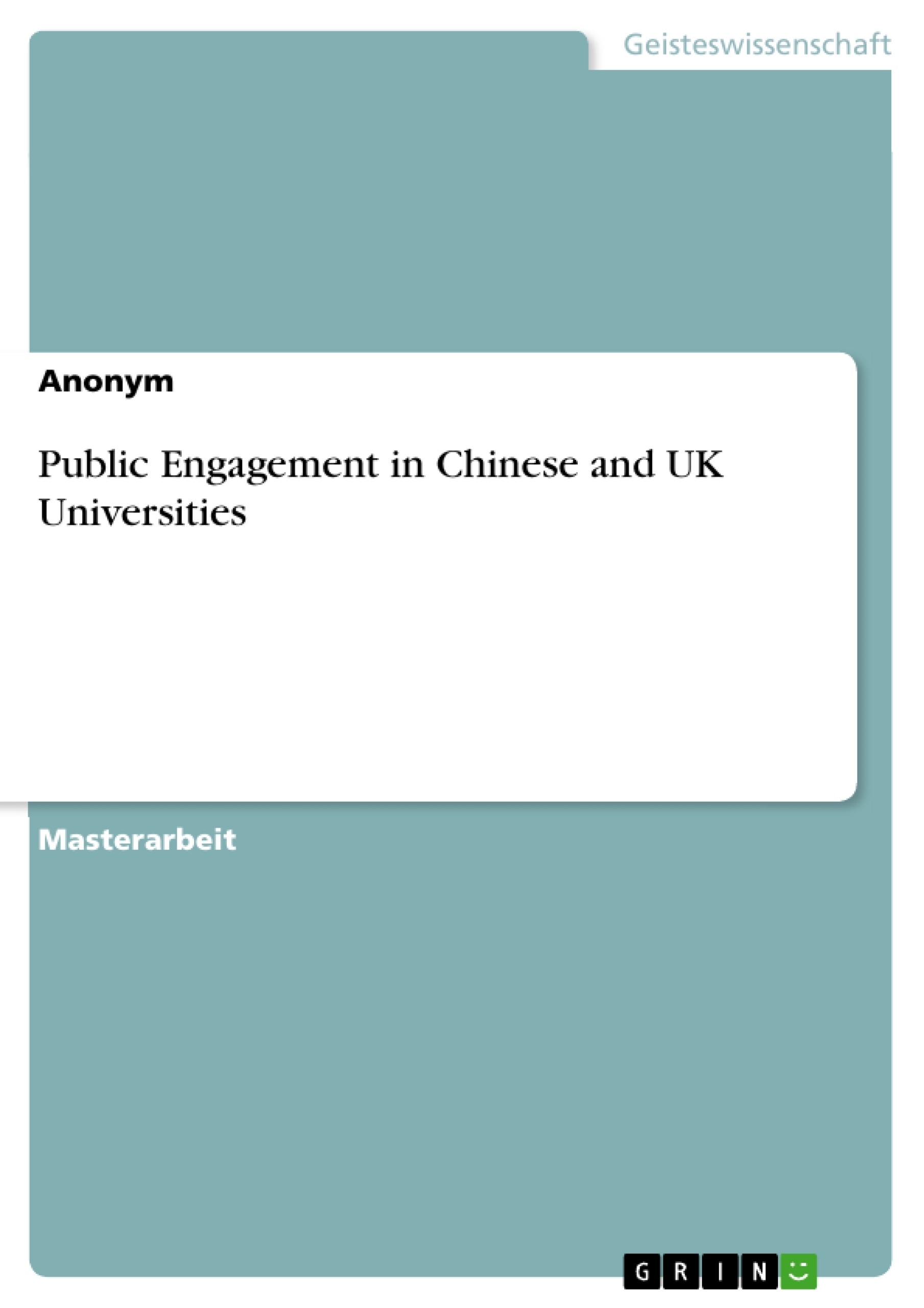The paper seeks to analyze the changing role of the universities in the society through the public engagements. It does this by evaluating the manner in which the government provides sufficient funding and how the community anticipates a more open culture of the universities towards the public and the responsiveness to societal needs.
It also helps engage in broader platforms with the public than before. Sharing of research allows people to gain benefits in learning and developing their lives. Moreover, the university’s staff can be in a position to improve the profiles of the universities, assist in the identification of new funding streams as well as strengthen the research funding for the universities. And finally, the research gives an insight into how public and community engagement by universities helps to open up new avenues for research.
Public engagement describes the manner in which university staff and students tend to interact with the public. It is a vital aspect of the university students and a highly beneficial program to the government. It is required that the concept of community and public engagement by universities be incorporated into the visions and strategies of the institutions.
The aspect of public engagement explores new and improved platforms of communicating with the public through collaborative working, appreciation of the local knowledge, listening and identifying the different perspectives in the society. Universities in China engage in community and public interactions through cultural celebrations, public discussions, citizen experiments, life learning courses and community social and learning groups. They are among the best available platforms for creating two-way conversations between the society and the universities.
Inhaltsverzeichnis
- 1. Einleitung
- 1.1 Zweck der Masterarbeit
- 1.2 Motivation des Themas
- 1.3 Wichtige Ergebnisse
- 1.4 Struktur der Dissertation
- 2. Literaturübersicht
- 2.1 Innovation
- 2.1.1 Definition von Innovation
- 2.1.2 Warum ist es wichtig?
- 2.2 Faktoren, die mit erfolgreicher Innovation verbunden sind
- 2.2.1 Verständnis der Benutzerbedürfnisse
- 2.2.2 Führung
- 2.2.3 Die Rolle von Innovation
- 2.2.4 Gutes Networking
- 2.3 Institutionen, die an Innovation beteiligt sind
- 2.3.1 Unternehmen
- 2.3.2 Regierung
- 2.3.3 Universitäten
- 2.4 Hauptaktivitäten von Universitäten - Als Ort der Innovation
- 2.4.1 Unternehmerische Universität
- 2.4.2 Beziehungen zwischen Universitäten und Industrie
- 2.4.3 Schlussfolgerung
- 2.1 Innovation
- 3. Konzeptioneller Rahmen
- 3.1 Gemeinschafts- und öffentliches Engagement durch die Universität
- 3.1.1 Definition
- 3.1.2 Beispiele
- 3.1.3 Warum?
- 3.2 Hochschulbildung in China
- 3.2.1 Verschiedene Arten von Universitäten in China
- 3.2.2 Verschiedene Aktivitäten von chinesischen Universitäten
- 3.2.3 Umfang des öffentlichen Engagements chinesischer Universitäten
- 3.3 Aspekte des Gemeinschaftsengagements
- 3.3.1 Arten von ausgetauschten Gütern
- 3.3.2 Stakeholder
- 3.1 Gemeinschafts- und öffentliches Engagement durch die Universität
- 4. Methodik
- 4.1 Untersuchungseinheit
- 4.1.1 30 Top-Universitäten im Vereinigten Königreich
- 4.1.2 30 Top-Universitäten in China
- 4.2 Umfrage
- 4.1 Untersuchungseinheit
- 5. Datenanalyse
- 5.1 Top 5 der wichtigsten Ähnlichkeiten
- 5.1.1 Ähnlichkeit 1
- 5.1.2 Ähnlichkeit 2
- 5.1.3 Ähnlichkeit 3
- 5.1.4 Ähnlichkeit 4
- 5.1.5 Ähnlichkeit 5
- 5.2 Top 5 der wichtigsten Unterschiede
- 5.2.1 Unterschied 1
- 5.2.2 Unterschied 2
- 5.2.3 Unterschied 3
- 5.2.4 Unterschied 4
- 5.2.5 Unterschied 5
- 5.1 Top 5 der wichtigsten Ähnlichkeiten
- 6. Diskussion
- 6.1 Hauptargumente für Ähnlichkeiten
- 6.1.1 Argument 1
- 6.1.2 Argument 2
- 6.2 Hauptargumente für Unterschiede
- 6.2.1 Argument 1
- 6.2.2 Argument 2
- 6.1 Hauptargumente für Ähnlichkeiten
Zielsetzung und Themenschwerpunkte
Diese Dissertation untersucht das öffentliche Engagement von Universitäten in China und im Vereinigten Königreich. Sie befasst sich mit den unterschiedlichen Ansätzen beider Länder und analysiert Gemeinsamkeiten und Unterschiede im öffentlichen Engagement von Universitäten. Das Ziel der Arbeit ist es, ein tieferes Verständnis für die Rolle von Universitäten in der Gesellschaft zu entwickeln und die Bedeutung des öffentlichen Engagements im Kontext von Innovation und gesellschaftlicher Verantwortung zu beleuchten.
- Öffentliches Engagement von Universitäten in China und im Vereinigten Königreich
- Gemeinsamkeiten und Unterschiede im öffentlichen Engagement von Universitäten
- Die Rolle von Universitäten in der Gesellschaft
- Öffentliches Engagement und Innovation
- Gesellschaftliche Verantwortung von Universitäten
Zusammenfassung der Kapitel
Das erste Kapitel dieser Dissertation führt in das Thema öffentliches Engagement von Universitäten ein und erläutert den Zweck und die Motivation der Arbeit. Das zweite Kapitel präsentiert eine umfassende Literaturübersicht über Innovation und die Rolle von Universitäten in der Innovationsprozesse. Kapitel drei stellt den konzeptionellen Rahmen vor, der zur Analyse des öffentlichen Engagements von Universitäten in China und im Vereinigten Königreich dient. Kapitel vier beschreibt die Methodik der Dissertation, die auf einer vergleichenden Analyse von 30 Top-Universitäten in China und im Vereinigten Königreich basiert. Kapitel fünf präsentiert die Ergebnisse der Datenanalyse, wobei sowohl die wichtigsten Ähnlichkeiten als auch Unterschiede im öffentlichen Engagement beider Länder hervorgehoben werden. Die Diskussion in Kapitel sechs analysiert die Ergebnisse und versucht, die wichtigsten Erklärungen für die beobachteten Muster im öffentlichen Engagement von Universitäten in China und im Vereinigten Königreich zu identifizieren.
Schlüsselwörter
Öffentliches Engagement, Universitäten, China, Vereinigtes Königreich, Innovation, Gesellschaftliche Verantwortung, Vergleichende Analyse, Gemeinsamkeiten, Unterschiede.
- Citation du texte
- Anonym (Auteur), 2017, Public Engagement in Chinese and UK Universities, Munich, GRIN Verlag, https://www.grin.com/document/379249



